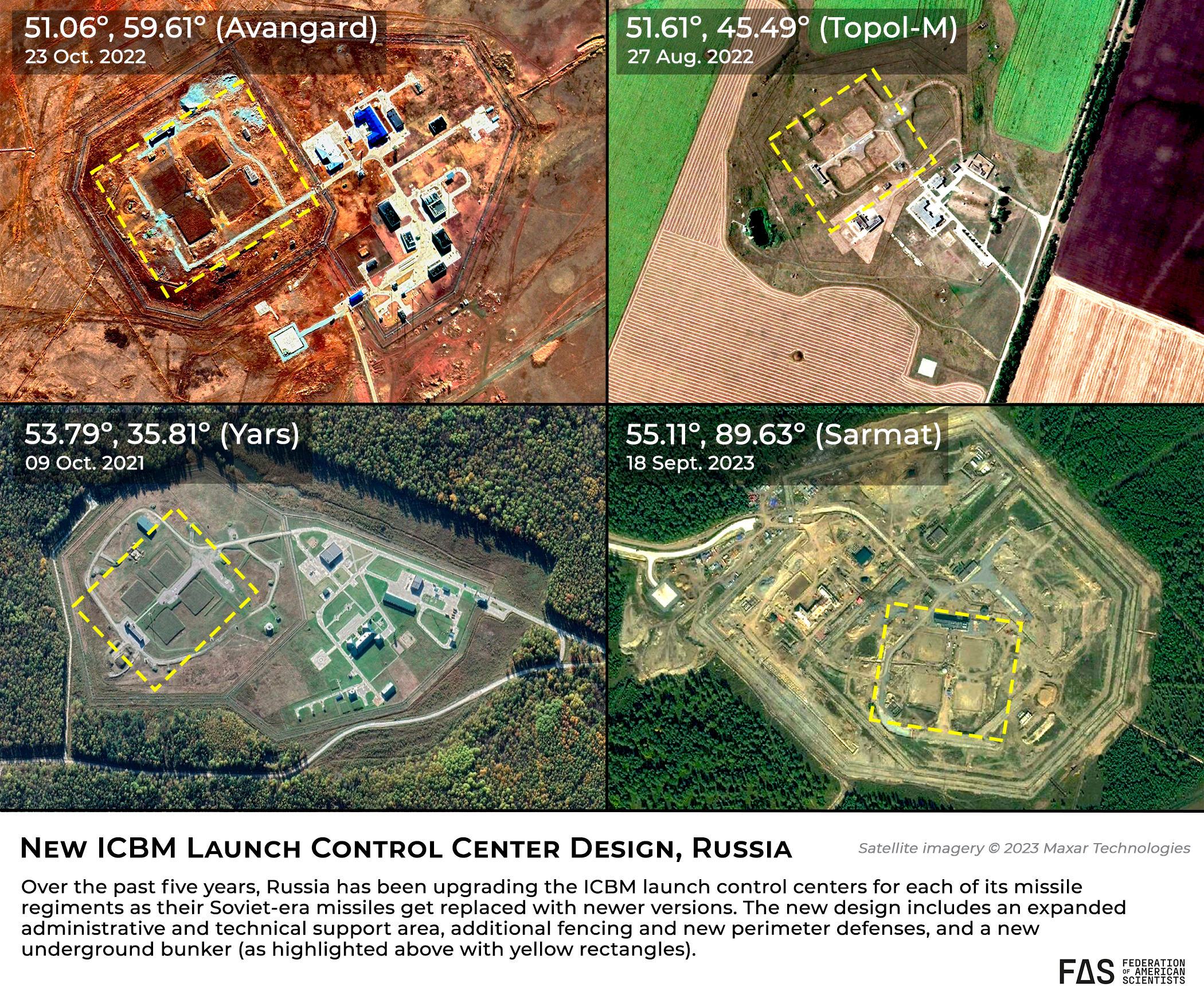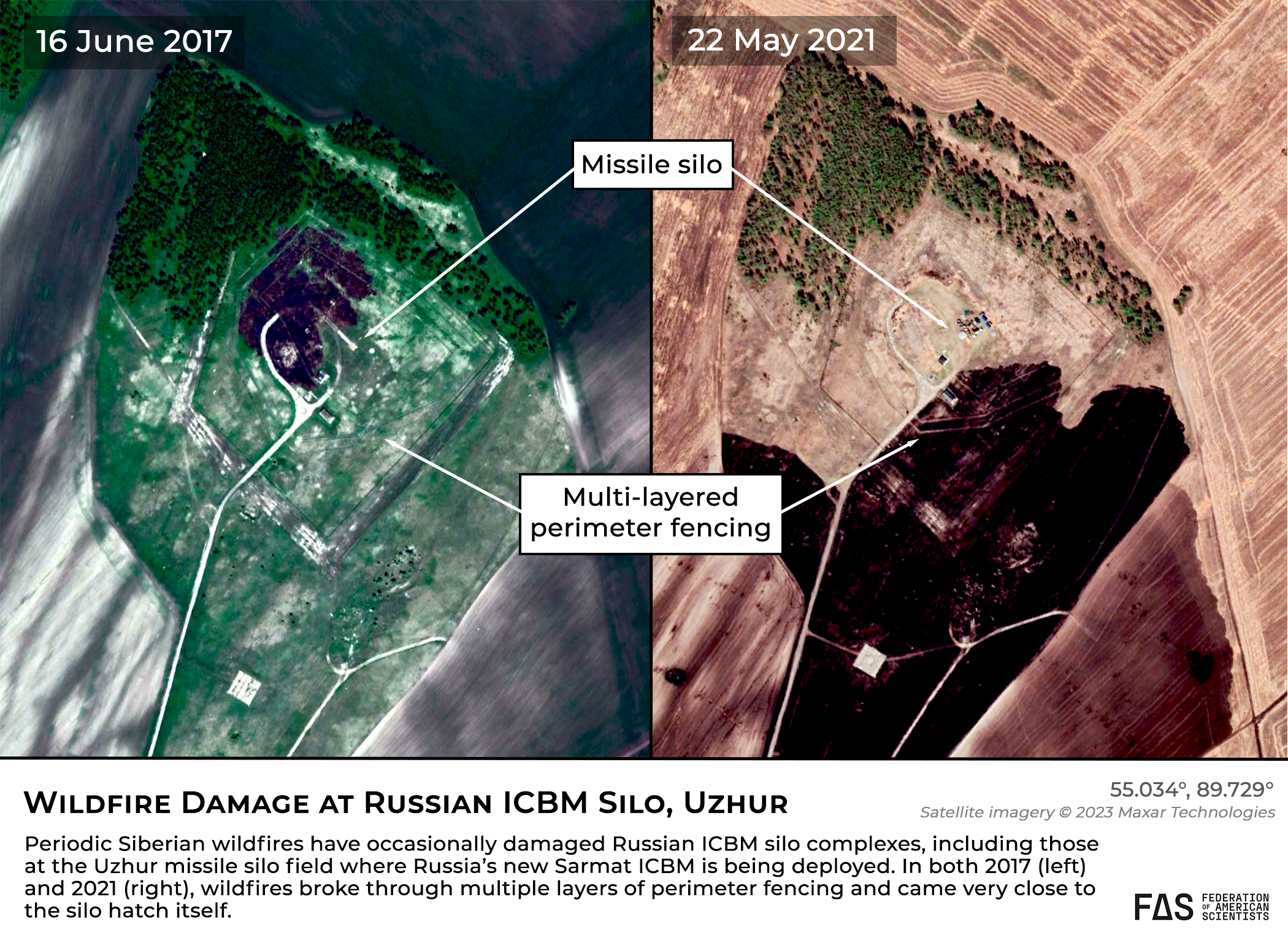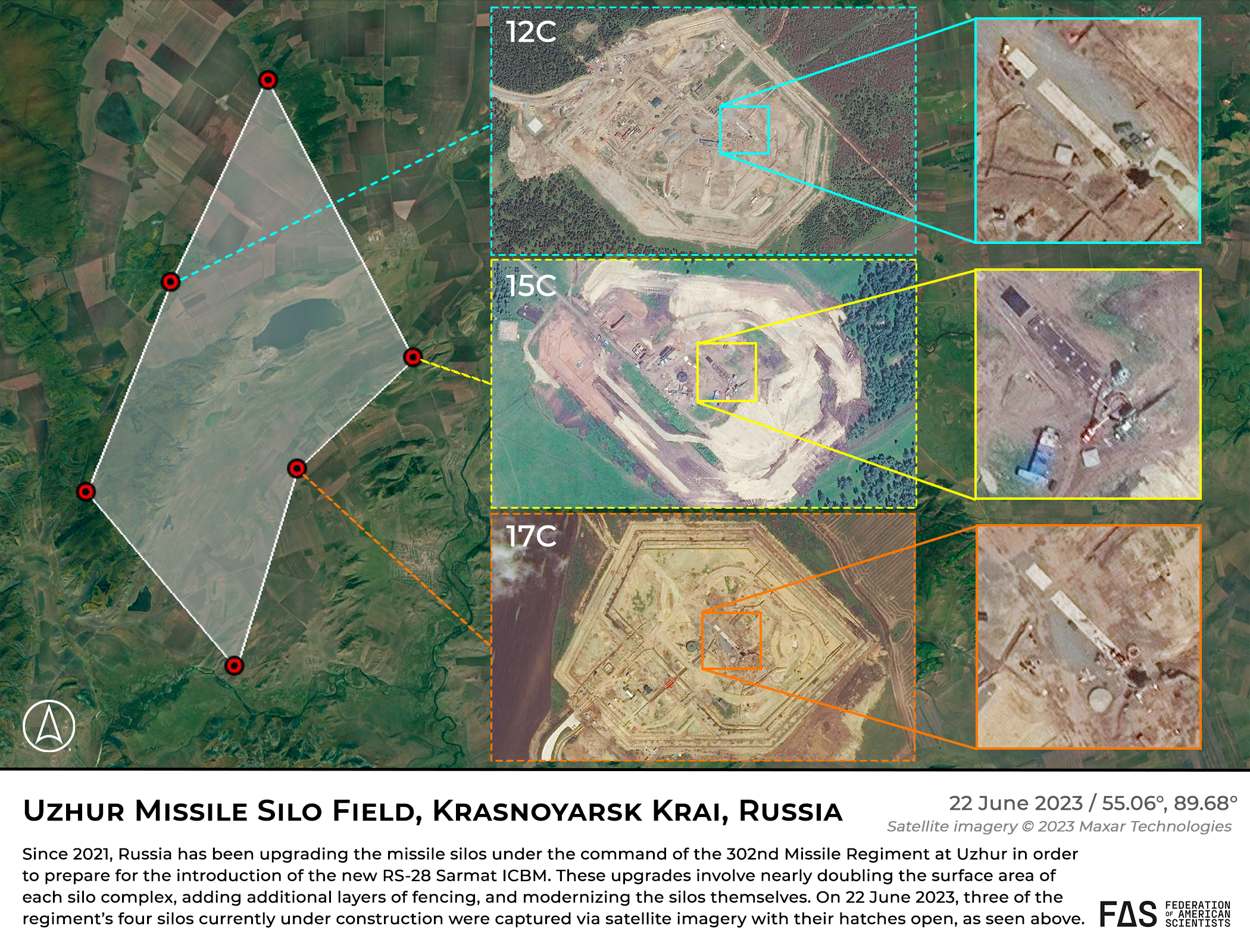
Upgrade Underway for Russian Silos to Receive New Sarmat ICBM
New satellite imagery shows that preparations to deploy Russia’s new RS-28 Sarmat (SS-29) intercontinental ballistic missile (ICBM) are well underway.
However, the imagery also indicates that President Putin’s claims of deployment “in the near future” may be too optimistic. It is potentially possible that one or two missiles could be deployed early, but major construction is still ongoing at many of the silos in the first regiment and has not yet begun at all of them, and the completion of construction at all eventual Sarmat regiments may be over a decade away.
The Sarmat––which was originally scheduled to enter service between 2018 and 2020 and will replace Russia’s aging RS-20V Voevoda (SS-18) ICBM––had been subject to significant manufacturing, production, and testing delays. In January 2022, the “War Bolts” Telegram channel reported that flight tests for Sarmat had been postponed due to problems with the missile’s command module. Following Sarmat’s eventual first test flight on 20 April 2022, Putin announced that the new ICBM would enter combat duty by the end of the year. As of October 2023, however, only one additional Sarmat flight test had reportedly taken place (in February 2023) and, according to US officials, likely ended in failure.
Despite the lack of successful tests, in November 2022 the General Director of the Makeyev Rocket Design Bureau––responsible for the design of Sarmat––claimed that the missile had already entered serial production. On 1 September 2023, Roscosmos Chief Yury Borisov announced that Sarmat had “assumed combat alert posture,” although this was likely premature: on 5 October 2023, President Putin noted during his speech at the Valdai Club that some “administrative and bureaucratic procedures” still needed to be carried out before Sarmat could be placed on combat duty, and on 7 October 2023, the Russian Ministry of Defence noted on Telegram that the “final stages” of construction and installation were still underway at the first launch facilities and associated command post.
New satellite imagery indicates construction is well underway at the first regiment of the 62nd Missile Division near Uzhur in south Siberia. It is expected that a total of 46 Sarmat missiles will eventually be deployed with seven regiments (six missiles per regiment, plus one 10-missile regiment) in two divisions at Uzhur and Dombarovsky.
The first missile regiment undergoing its upgrade to Sarmat is the 302nd Missile Regiment and consists of six silos. Major construction continues at the launch control center and its accompanying silo (12C) and three other silos (13C, 15C, and 17C). The two remaining silos (16C and 18C) have only received minor upgrades and will take many months to complete if scheduled for the same comprehensive upgrade as the other silos.
Silos 12C and 17C:
The first two silos to begin their upgrades were Silos 12C (55.1144°, 89.6344°) and 17C (55.0347°, 89.7286°), which began their upgrades in the spring and summer of 2021, respectively. Over the past two years, the perimeters at both sites were removed, reshaped, and expanded with additional layers of fencing. The surface area of both silos has nearly doubled in size: Silo 12C has been expanded from approximately 0.228 square kilometers to 0.427 square kilometers, and the area of Silo 17C has been expanded from approximately 0.082 square kilometers to 0.136 square kilometers.

As of mid-September, construction appeared to be nearly complete inside the inner silo areas at both sites. The launch control center at Silo 12C has been upgraded to a newer LCC design that can also be seen at other Russian ICBM complexes, including the SS-27 Mod 1 “Topol-M” silo field near Tatishchevo, the SS-27 Mod 2 “Yars” silo field near Kozelsk, and the SS-19 Mod 4 “Avangard” silo field near Dombarovsky. In addition, Silo 12C boasts a new gun turret placement and expanded administrative area, although this outer area is not yet complete.

Notably, the immediate area surrounding Silo 17C has been subject to significant wildfire damage in the past. In 2017, a wildfire burned through all three sets of perimeter fencing and damaged the inner road leading to the silo hatch. In May 2021, another wildfire again burned through the three layers of fencing and appeared to damage an administrative building near the hatch.

Silos 13C and 15C:
Silos 13C (55.2008°, 89.7061°) and 17C (55.0822°, 89.8155°) began their upgrades in late-2022, nearly 1.5 years after construction on the first two silos began. As of mid-October 2023, significant construction at both sites was still underway, including underground and inside the silos themselves. Trees have been removed at both sites to make space for the expanded perimeter fences. While the new perimeters at both sites have been marked out, the multiple layers of fencing have not yet been completed. New gun turrets at both sites now appear to be in place.

Use the Planet Labs PBC interactive slider to compare before/after images.
Silos 16C and 18C:
As of mid-September 2023, full-site construction at Silos 16C (55.0247º, 89.5711º) and 18C (54.9501º, 89.6833º) had not yet begun, although some silo maintenance work has been visible since mid-2021, possibly in preparation for the full-site construction.
Open silos
It is notable that satellites have managed to capture images of all four silos currently under construction with their hatches open; on more than one occasion, multiple different silos could be seen with their hatches open on the same day, and in some cases hatches have stayed open for days at a time. This suggests that operations to upgrade the silos themselves and preparations to deploy Sarmat ICBMs inside them––as touted by high-ranking Russian officials––are well underway.

Additional information:
• Nuclear Notebook: Russian Nuclear Weapons, 2023
This research was carried out with generous contributions from the New-Land Foundation, Ploughshares Fund, the Prospect Hill Foundation, Longview Philanthropy, and individual donors.
The FAS Nuclear Notebook is one of the most widely sourced reference materials worldwide for reliable information about the status of nuclear weapons, and has been published in the Bulletin of the Atomic Scientists since 1987. The Nuclear Notebook is researched and written by the staff of the Federation of American Scientists’ Nuclear Information Project: Director Hans […]
In contrast to the Biden administration’s Nuclear Posture Review, the Congressionally-mandated Strategic Posture Commission report is a full-throated embrace of a U.S. nuclear build-up.
The Belarusian military has completed what appears to be a new garage facility for the allegedly nuclear-capable Iskander missile launchers it received from Russia.
New satellite images show that the construction of a double-fenced security perimeter is underway at a weapons depot near the town of Asipovichy in central Belarus.